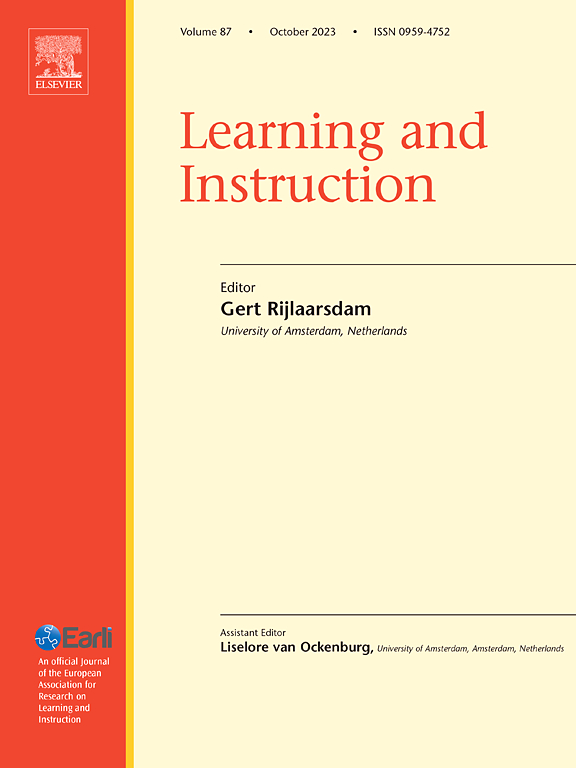学前数学弹性与执行功能
IF 4.9
1区 教育学
Q1 EDUCATION & EDUCATIONAL RESEARCH
引用次数: 0
摘要
来自弱势社会经济背景的儿童在学前班已经表现出比条件较好的同龄人更差的学术技能,并且在正规学校遇到学习困难的风险更高。然而,并非所有面临逆境的孩子都会经历负面的学业成绩。有些孩子表现出学业上的适应力,他们的表现与条件更优越的同龄人相当。目的研究学龄前儿童是否存在数学弹性,执行功能是否与数学弹性相关,以及早期数学弹性状态是否与6年后的数学成就相关。样本包括1132名儿童(Mage = 57个月,SD = 3.9;(51%为女性)在新加坡上幼儿园。方法采用以人为本的方法对适应力强的儿童(在学龄前两年内有数学发展的风险,打破了风险相似的同龄人的平均趋势)进行鉴定。使用多群体混合成长模型将他们的成长轨迹与来自更有利背景的儿童的轨迹进行匹配。结果发现了一种弹性特征(占风险样本的6%),这与后来的数学成就有关。智力,而不是执行功能,预测了恢复状态。母亲教育成为一种保护因素,而不是风险因素。结论:研究结果强调了高危儿童数学发展的异质性。幼儿的数学弹性是建立在基本的认知能力和环境资源的结合之上的,这两种能力可以防止最初的失败,而环境资源可以随着时间的推移而持续增长。本文章由计算机程序翻译,如有差异,请以英文原文为准。
Mathematics resilience in preschool and executive functions
Background
Children from disadvantaged socioeconomic (SES) backgrounds already show poorer academic skills than their more advantaged peers in preschool and are at higher risk of experiencing learning difficulties in formal school. However, not all children facing adversity experience negative academic outcomes. Some children show academic resilience, performing at the level of their more advantaged peers.
Aims
This study investigated whether mathematics resilience is observed in preschool children, whether executive functions are associated with mathematics resilience, and whether earlier resilience status relates to later mathematics achievement (six years later).
Sample
The sample included 1132 children (Mage = 57 months, SD = 3.9; 51 % female) attending preschool in Singapore.
Methods
Resilient children (at-risk with math development over two preschool years that breaks the average trend of their similar-risk peers) were identified using person-centered methods. Their trajectories were matched against those of children from more advantaged backgrounds using multigroup mixture growth model.
Results
One resilient profile was identified (6 % of the at-risk sample), which was associated with later mathematics achievement. Intelligence, but not executive function, predicted resilience status. Maternal education emerged as a protective factor rather than a risk factor.
Conclusions
Findings highlight the heterogeneity in the development of mathematics among at-risk children. Young children's mathematics resilience is built upon a combination of foundational cognitive aptitude that protects against initial failure, and environmental resources that sustain growth over time.
求助全文
通过发布文献求助,成功后即可免费获取论文全文。
去求助
来源期刊

Learning and Instruction
Multiple-
CiteScore
11.30
自引率
4.80%
发文量
109
期刊介绍:
As an international, multi-disciplinary, peer-refereed journal, Learning and Instruction provides a platform for the publication of the most advanced scientific research in the areas of learning, development, instruction and teaching. The journal welcomes original empirical investigations. The papers may represent a variety of theoretical perspectives and different methodological approaches. They may refer to any age level, from infants to adults and to a diversity of learning and instructional settings, from laboratory experiments to field studies. The major criteria in the review and the selection process concern the significance of the contribution to the area of learning and instruction, and the rigor of the study.
 求助内容:
求助内容: 应助结果提醒方式:
应助结果提醒方式:


